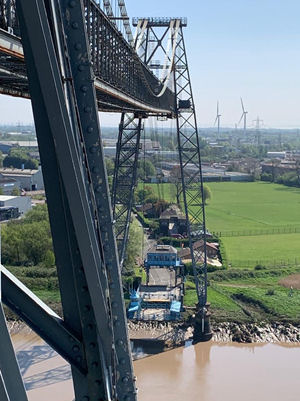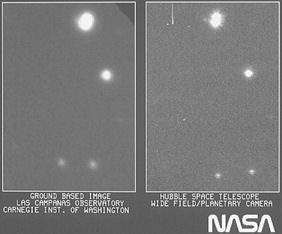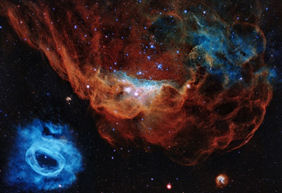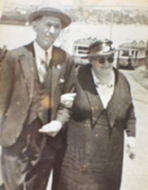Dates for your Diary
Closed until further notice
100 Club
Draws suspended pending re-opening. Draws will be backdated so no-one will lose out.

Reader and supporter Mrs Chris Budd, celebrated her 90th birthday last month under lockdown. One birthday she won’t forget in a hurry! Please join with me in wishing her all the best for the year ahead.
Newport Transporter Bridge Update
Last month I reported on the planned new visitor centre for Newport’s Transporter Bridge. My sister, Alison Williams, reminded me that, last Easter, she and her husband climbed the 277 steps to the platform and walked across the bridge. She took some spectacular photos, one of which is reproduced here. To see more of my sister’s photos including the pedestrian walkway itself, visit the museum’s Facebook page.

A view of the ‘Gondola’ from part-way up the steps.
Report Scam Emails
The National Cyber Security Centre (NCSC) has launched a suspicious email reporting service in partnership with the City of London Police. Members of the public can forward their suspicious emails to report@phishing.gov.uk and any sites found to be phishing scams will be removed. The public can also report any type of suspicious phone text / SMS messages to their service provider by forwarding the original message to 7726, which spells SPAM on their keypad.
THIRTY YEARS AGO
There was once a time when the stars and planets were a wondrous mystery. As early as 5000 years ago inquiring minds stared plotting and naming the constellations and planets and the knowledge of our skies took a big leap forward with Galileo's studies using his telescope in the early 1600s. Now move forward 400 years. The discoveries revealed by the Hubble telescope over the last thirty years are staggering and the images sent back are, without exception, simply stunning. Perhaps even more amazing is the realisation of how very much more there is still to learn about our universe.
In the twentieth century astronomical telescopes became larger and larger and increasingly sought out remote mountain-top sites but, however sophisticated, there remained the problem of 'seeing' through the earth's atmosphere with the problems of distortion, rain clouds and light pollution. The answer was to launch a telescope into space where it would have an unobstructed view of the universe, enabling study not just of our own solar system and galaxy, but also distant stars, gas clouds and galaxies.
How did the project start? Dr Edwin Hubble, after whom the telescope was named, was an astronomer who discovered that galaxies seemed to be moving away from each other, suggesting an expanding universe and raising questions that needed answering. There were a number of projects to launch telescopes in space but nothing matched the project for the telescope we now know as Hubble which was launched on a space shuttle on 24th April 1990.
The first images were disappointing – grainy and blurred. It transpired that the mirror had not been sufficiently accurately ground and a mission was put together to launch a space shuttle carrying astronauts who would carry out repairs and install new equipment which could correct the focussing and produce sharp images. Imagine the tension waiting for the first new images after the refit! Fortunately the work was successful and today we are able to see thousands of stunning and clear Hubble images.
There is, of course, much more to the story of the Hubble telescope but if you are interested there is plenty to read on-line. Also, of course, you can access the wonderful Hubble images of space using the NASA website:
https://www.nasa.gov/mission-pages/hubble/multimedia
In the meantime, here is a montage which shows the first picture from Hubble compared with a comparable photo taken from a ground based observatory. Also featured below is the colourful and exquisite image taken on Hubble's thirtieth birthday – the photo shows the nebulas known as NGC2014 and NGC2020 and the picture has been nicknamed 'The Cosmic Sea' because it looks like an underwater world.

Left, ground based photo and right, an early Hubble photo – not much difference.
Can’t wait for the day I can walk down the aisle and hear those magical words…”this is your captain speaking”

30 years on and a recent photo from Hubble of nebulae NGC2014 and NGC2020.
Jen Price
Sydney Charles Paget
My name is Marie Hobson and I live at Gunnedah, New South Wales, Australia and I have links to Abertillery. Jen Price invited me to write a little article for your newsletter and introduce myself.
I live with my husband Glen whose maternal grandparents, Sydney & Ellen Paget, migrated to Australia from Wales in 1922. Glen’s grandfather, Sidney Charles Paget, served with the Kings Royal Rifle Corps in the Great War. We have no photo of him in military uniform and we are hoping to get replicas of his service medals. We believe his medals were buried with him. We would love to know if his service has been remembered on any war memorials in Abertillery where he enlisted. Among his treasured items was a photo of the Abertillery War Memorial.
I am secretary of the Gunnedah & District Historical Society, our museum is housed in the town’s first water reservoir so it is rather unique - it took 10 years of volunteer labour to complete. The Gunnedah Water Tower Museum has murals painted on the exterior walls honouring our Vietnam War veterans. You can see them on our Facebook page.
I would like to tell you all about it at another time. I have looked at your website and you also have a wonderful facility and obviously many activities.
Warm regards,
Marie
Sidney Charles Paget was born, at Wellow, Somerset, England, on January 20, 1878. He married Ellen Elizabeth Fletcher. Before his enlistment in the army in 1915, Sidney Paget had been working as a coal miner in the pits at Abertillery where his daughter (my mother-in-law) Gertrude Maud Paget was born on May 26, 1914. She was the youngest of six children.
It is hard to imagine why Sydney would have wanted to join a war in Europe when he had such a large family to support, but research has revealed that there had been a lengthy miners' strike in Wales which did not end until September, 1915, when the miners resolved their dispute and returned to work with the mantra: "Tell the Allies, the miners will do their duty". It is likely that he could not afford the luxury of striking and so he enlisted in the army.
Rifleman Sidney Paget was attached to The British Expeditionary Force (BEF), the name given to the British Army sent to the Western Front.
He saw action in the Somme and unfortunately was exposed to mustard gas which remained potent in the ground for weeks after it was released (in trenches and dugouts) and made it difficult to capture trenches that were infected. Mustard gas was toxic in concentrations that were undetectable at the time of exposure specifically by the sense of smell and an affected person suffered no discomfort at the time of exposure. Private Sidney Paget's lungs were affected and after one year and sixty-nine days of service, he was medically discharged "no longer fit for war service".
 His discharge papers described him as "a good, hard working and sober man; will probably require light work for a time ‘til his nerves are restored". It was signed by Captain W. Judge, Commander of the Rifle Depot, on March 8, 1916. Rifleman Paget's character reference certified that "his service with the colours, has been very good". He was awarded the 1914-1915 British Star, the Victory Medal and the BEF France Medal. We have been told that these medals were buried with him.
His discharge papers described him as "a good, hard working and sober man; will probably require light work for a time ‘til his nerves are restored". It was signed by Captain W. Judge, Commander of the Rifle Depot, on March 8, 1916. Rifleman Paget's character reference certified that "his service with the colours, has been very good". He was awarded the 1914-1915 British Star, the Victory Medal and the BEF France Medal. We have been told that these medals were buried with him.
With poor health after the war, Sidney and Ellen Paget followed other coal-mining families from Abertillery to Australia for a warmer climate. They sailed on the steamer TSS Hobson's Bay on July 4, 1922 as third class steerage passengers. Accompanying Sidney and Ellen Paget were their daughters Dorothy (20), Fred (17), Alice (11) and Gertrude (8). Their eldest son Herbert was already married with a family and stayed in England. They sadly left the grave of their infant daughter Matilda Maud, who died at the age of 3 months.
Sidney Paget worked for a time at Blackjack Coal Mine near Gunnedah NSW and died at the age of 64, on April 18, 1940. He and his wife Ellen are buried at the Hunter Street cemetery, Gunnedah. Gertrude Maud Paget went on to marry Ernest Richard Hobson at Gunnedah in 1934 and had 5 children one of whom of course is my husband Glen.
A History of Eurovision
Love it or hate it, the Eurovision song contest has been a regular on our screens for over 60 years until, that is, this year when covid-19 forced its cancellation for the first time in its long history. This year there was a just a broadcast of 30 seconds of each country’s song but that was all and no winner was selected.
The very first contest was held on 24th May 1956 in Lugano, Switzerland and just seven countries took part; Belgium, France, Germany, Italy, Luxembourg, Netherlands and of course the host country Switzerland, each singing not one but two songs. Not many people had televisions in the fifties so the show was primarily a radio show. This was the one and only year that each country preformed two songs. It was won by Switzerland with their song ‘Refrain’. It was also a rule at the time that the song had to be performed in the countries native tongue though this was relaxed in the 70’s allowing ABBA to win with ‘Waterloo’(songs sung in English were deemed to have a higher chance of winning).
In March 1957 the contest was held in Germany (it would be many decades before it finally settled on May, varying between March, April and May until then). This time the UK took part along with Austria and Denmark bringing the number of participating countries to 10. We were represented by Patricia Bredin who came 7th while the Netherlands won with their song ‘Net als toen’ which translates as ‘Just like then’.
The third contest, in 1959, took place at Hilversum in the Netherlands and this marked the start of the tradition of the host country being the previous year’s winner.
The UK’s first winner was ‘Puppet on a String’ sung by Sandie Shaw in 1967. By this time the number of competing countries had expanded to 17 and was now being watched by millions around the world on televisions.
The show in 1969 was held in Spain as they had won the previous year with ‘La, La La’. This time there was a four-way tie for the title. This had never happened before and with no precedent for it, all four songs were declared the winners. We were one of the four winners, thanks to Lulu and her song ‘Boom Bang-a-Bang’ but we shared the title with Spain, France and the Netherlands.
As we had hosted the show in 1968, and Spain in 1969, a coin was tossed to decide between France and the Netherlands to host the 1970 show and the toss was won by the Netherlands. However a number of countries (Finland, Norway, Portugal, Sweden and Austria) were unhappy about the way the next host country had been selected and, as a result, pulled out of the 1970 show leaving just 12 competing. The host country was forced to ‘pad’ the show out using video footage to introduce each artist and this format has not changed much in all the decades since.
The UK won again in 1976 thanks to Brotherhood of Man with ‘Save Your Kisses for Me’ and in 1981 with B ucks Fizz singing ‘Making Your Mind Up’. Our fifth and final win to date was in 1997 when ‘Katrina and the Waves’ brought the trophy home with ‘Shine a Light’ and this song was the one chosen, very aptly, to close this year’s show, sung by every single 2020 entrant.
In recent years more and more countries have joined the competition (41 at present); even Australia now takes part and it can hardly be classed as part of Europe. The performances have become less about the song and more about putting on a show with bizarre costumes, dances and props and, some would say, the voting has become somewhat political (Greece always voting for Cyprus, Cyprus for Greece with the Baltic states happily passing the vote around) which has meant that overall we in the UK have done abysmally of late.
The country that holds the title for the most wins is Ireland with 7 wins. They also hold the title for winning three consecutive years (1992, 1993 & 1994). But we can boast a record or two also, because the UK, and this is regarded as one of the biggest achievements in the history of Eurovision, holds the record for coming in second place a massive 15 times! (Remember Sir Cliff’s ‘Congratulations’ and The New Seekers’ ‘Beg, Steal or Borrow’ to name but two?). And we also hold the record for the longest-running string of being in the top 5.
We’ve also hosted the competition 8 times, stepping in no less than three times when the winning country was unable to host the show.
So next time we are at the bottom of the leader board with ‘nil points’ let’s remember these facts and hold our heads up high!
Sally Murphy
Top Of Page
